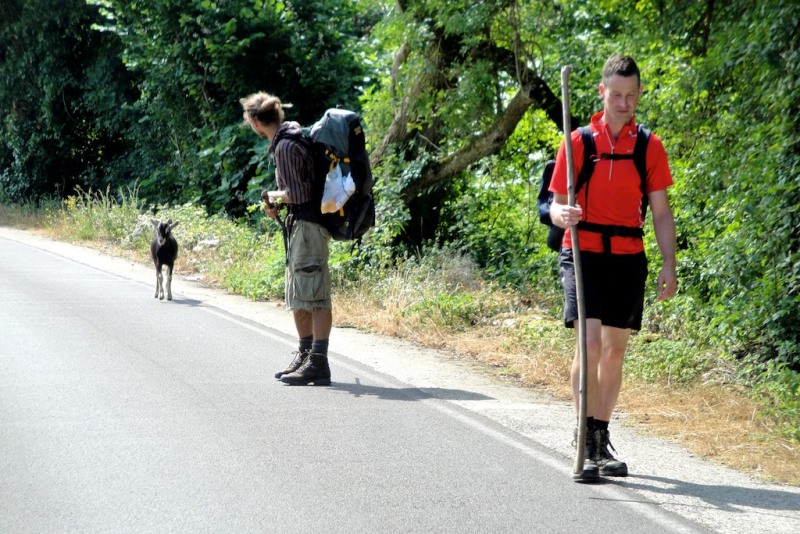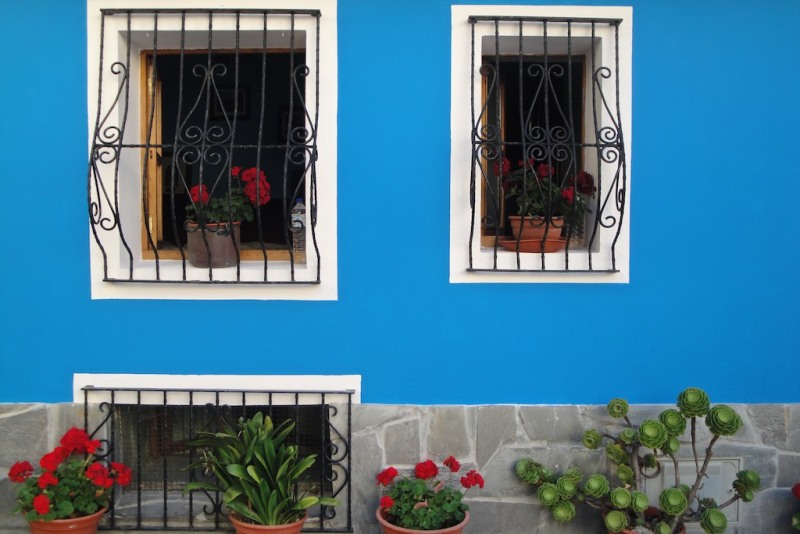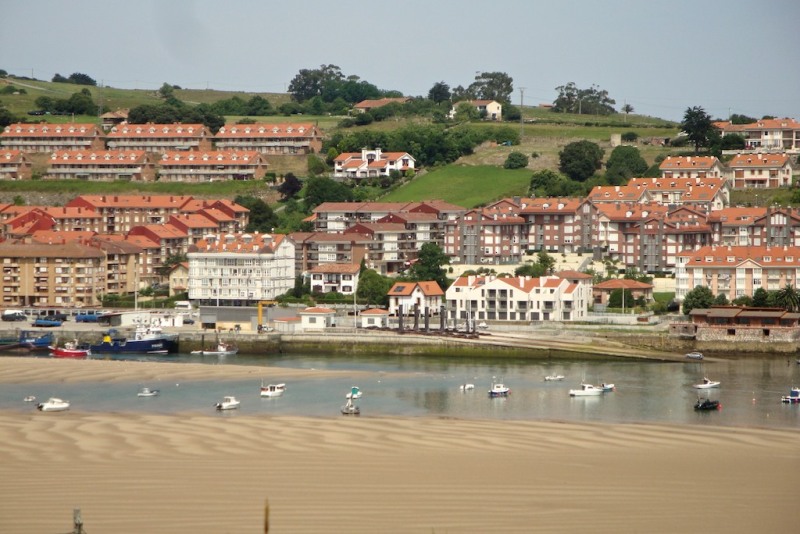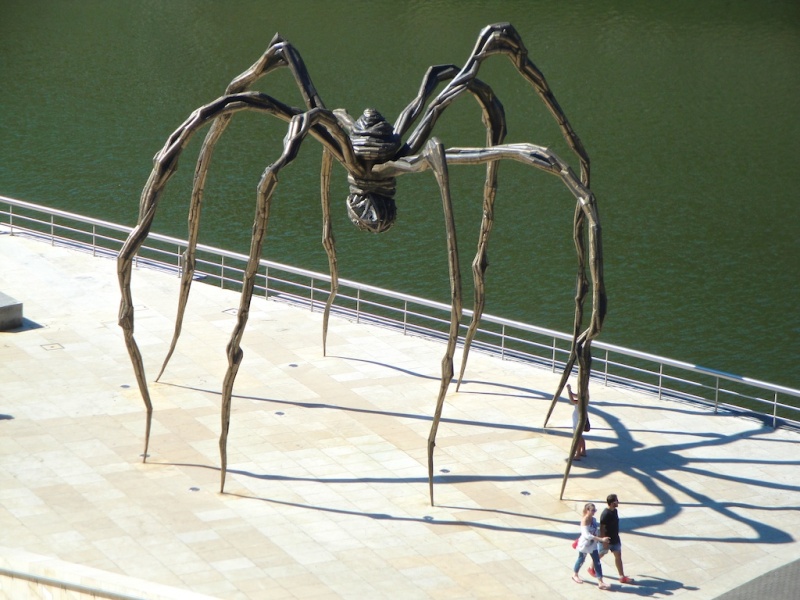In June 2015, I ventured on a 3-week solo hike along Northern Spain starting in Irún (Basque Country) and finishing in Oviedo (Asturias). This is the third post in my Camino series – click here if you missed the first and/or second post!
On my 16th day, I kicked-off in Serdio (Cantabria) at 7:45 AM (which, admittedly, wasn’t even that early) and arrived in Llanes (Asturias) more than 12 hours later. It was, without any doubt, my longest day on the Camino (which also made it one of the hardest ones). But looking back, it’s also the one I remember most fondly.
Maybe because I didn’t rush it. Maybe because I did it my own way – stopping to take a photo or going off the official route whenever I wanted. Or maybe because I had the perfect combination of solo and social time.
Although probably what really made my day was having a baby goat following us along the way.
I walked slow and took in as much from the landscape as I could. Eventually, my Camino family split for the day and I found myself in a not-so-well-marked coastal area on my own – doubting my own orientation skills. Soon enough, though, I saw Klaus (do you remember him?): at that point, I knew I was at least going in the right direction.
Shortly after, I was caught up by two Germans doctors and an English girl – with whom I explored hidden caves (how cool is that?) and had one too many sidras (cider) in Buelna. Later in the afternoon, outside a tiny market in Pendueles, I met a Spanish peregrino who soon became my companion for the rest of the afternoon to Llanes.
I walked about 38km on that day. I fell on my face when trying to climb a passage and got caught under drizzly rain. I never felt so much pain in my feet and honestly doubted I would ever get to Llanes in one piece. Ultimately, I almost cried when I was informed that the entire city of Llanes was booked out that night (and we were suggested to continue walking! another 5km! are they crazy?).
But somehow, it all worked out. I found a hotel room (the very last one) – and even got a pilgrim discount. I was on some kind of tiredness-fuelled energy high that even got me out of that lovely room to have more celebratory sidra that night. While I shared my pictures of caves, rugged coastlines, green hills and bird-eye view of Llanes I kept on thinking to myself: wow, I actually did it!
So it’s no surprise that I decided to take the next day off walking. Or at least, off long-distance trekking – as, for some reason, I just couldn’t sit still. After wandering through the streets of beautiful Llanes (above), I headed off along the coastline to the next small town with an albergue (Po). And then, on to the next one (Celorio).
The entire Concejo de Llanes has an incredible amount of beautiful natural beaches surrounded by luscious green hills. I’m determined to return to Llanes next summer for a longer period just to spend more time exploring the coast!
The walk to Ribadesella on day 18 felt surprisingly easy! Granted, there was hardly any hight difference and the path was a rather balanced mix of road and trail – leading through small villages, grassy fields and great cultural sights (such as the above of the Iglesia de Nuestra Señora de los Dolores in Barro).
My favourite bit of this day was, without doubt, the entrance into Ribadesella through the colourful old fishers town of El Portiellu.
My Camino family split in Llanes – so at the time we reached Ribadesella, only 3 of us were left. You would think that having to say goodbye to people you’ve only met 2 weeks ago would be easy, but when you’ve been through hell and heaven on the Camino, your relationship to those around you is intensified.
As my deadline and destination goal was approaching as well, I felt a bit blue (for the lack of a better word).
On the 19th day, we walked roughly 20km to Colunga – a big part of it along the Camino Real, which covers the local beaches and surrounding hills. It was a beautiful day to walk – not too hot, not too cold (although the latter had never really been the issue, really!).
While sitting in a beach café in La Isla with Sara, we overheard a group of women discussing the disappearance of a female pilgrim on the Camino Francés earlier this year. We were both aware of this event (in fact, Sara had packed a pepper spray can in her backpack), but it didn’t stop us from going solo. Nor did it stop many other female travellers we crossed paths with over the past 3 weeks. It made us realise that there hadn’t been a moment when we felt in danger.
Yes, terrible things happen sometimes. When walking on a less-frequented paths, I was always alert and intuitive and usually knew how far/close the next group of pilgrims were. And by doing this, I always felt safe.
On my last day as part of (what was left of) my Camino family, we walked 18km to Villaviciosa – the apple capital of Spain. Yes, there was certainly lots of cider!
We reminisced about the many stories we collected along our Camino and remembered all the people we had met. We promised to keep in touch (thanks, Facebook!) and to always remember this experience.
As my final Camino day arrived, I was equally excited and sort of heart-broken. I actually didn’t really want this adventure to end! Soon after leaving Villanueva, I reached the point at which the Camino divided in two parts: on the right, it would continue to Gijón along the Camino del Norte, and on the left, it would route towards Oviedo – the start of the Camino Primitivo.
Towards Oviedo, I came across de impressive pre-romanesque Monasterio de San Salvador de Valdediós (below).
After the Monastery, the path went uphill to Alto de la Campa (photo below) – constantly allowing me to peek over the Valley from different angles.
I had heard that, on the Camino Primitivo, signs were less frequent and sometimes a bit confusing. True – In fact, I even came across conflicting signs! But somehow, with a bit of intuition, I didn’t get lost on this rather solitary path. During the whole day I only came across 2 fellow pilgrims, so I guess most of them decide to continue along the Camino del Norte to Gijón instead!
At Vega del Siero I hopped on a bus with one of the wisest pilgrims I had come across with: a french retiree who who had already walked over 1000km starting in France. She reminded me of how personal the Camino is:
There’s really no right or wrong way of walking it. No age, belief or physical requirements. There’s no minimum distance and no real schedule (but the one you build up in your head). And there’s nobody to impress or feel judged by (but ourselves).
That afternoon, I arrived in Oviedo without much of a plan but to walk through the old town, explore every inch of the city and eat local bonito del norte a la plancha (below) before saying goodbye to the Camino (for now!).
Have you been to Asturias in Spain?
My Camino: notes and snapshots of Basque Country (Spain) is the third post of my Camino series:
- Day 1 – 8 : Basque Country (roughly 180km)
- Day 8 – 16: Cantabria (roughly 160km)
- Day 16 – 21: Asturias (roughly 136km)
















































